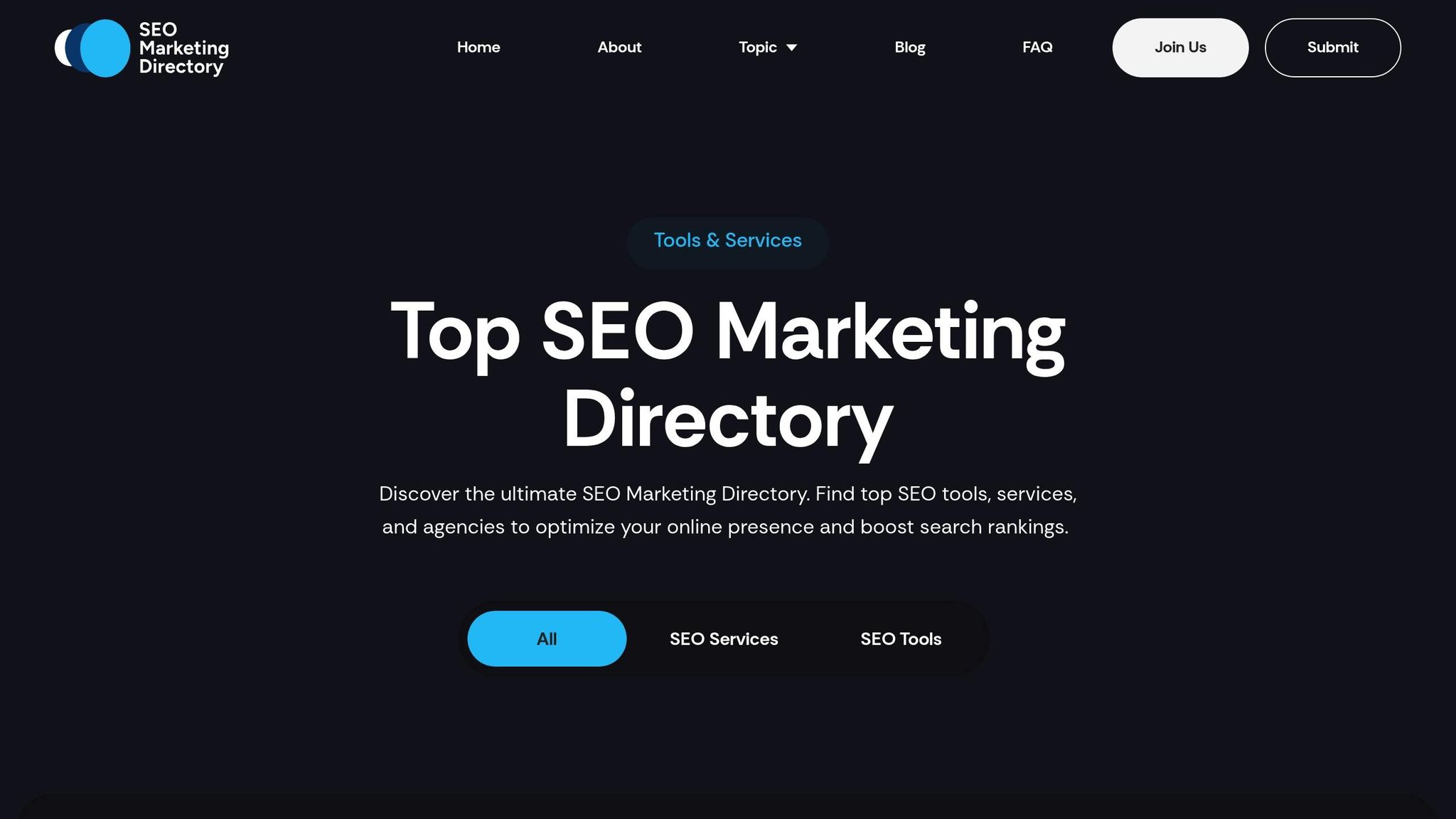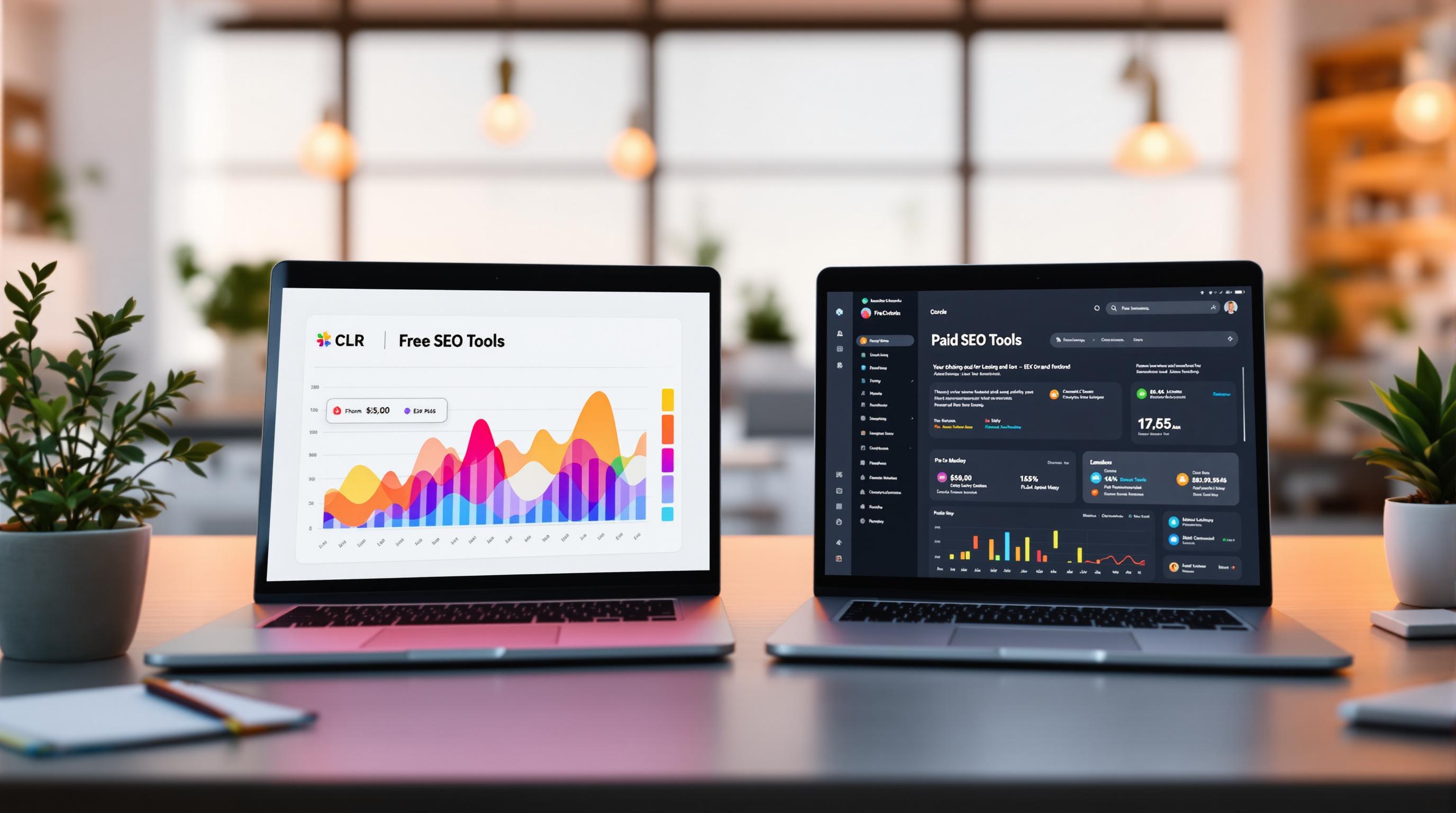If you want executives to back your SEO efforts, your reports must focus on what matters to them: business outcomes. Metrics like keyword rankings or traffic numbers won’t cut it unless they’re tied to revenue, cost efficiency, or competitive growth. Here’s the key takeaway: translate SEO metrics into clear, actionable insights that align with company goals.
What executives care about:
- Revenue growth: Show how organic traffic converts into sales.
- Cost efficiency: Highlight lower customer acquisition costs compared to paid channels.
- Market share: Use data to demonstrate competitive positioning.
- Customer lifetime value: Connect SEO to long-term customer engagement.
How to present SEO data effectively:
- Simplify technical terms: Skip jargon like "crawl budget" or "schema markup." Instead, emphasize outcomes like increased conversions or improved engagement.
- Choose the right metrics: Focus on qualified organic sessions, conversion rates, and revenue-driving keywords. Compare SEO performance to other channels for context.
- Use visuals and storytelling: Charts, dashboards, and side-by-side comparisons make trends easy to grasp. Pair them with a narrative that connects challenges, actions, and results.
- Be consistent: Stick to a core set of metrics, report regularly, and account for seasonality or business cycles.
- Provide action plans: Don’t just present data - recommend next steps tied to specific improvements, like optimizing high-performing pages or addressing technical issues.
Tools to consider:
- Ahrefs and Semrush: For tracking keyword rankings and backlinks.
- Google Looker Studio: For creating executive-friendly dashboards.
- Google Analytics 4: For linking organic traffic to revenue.
SEO Reporting & C-Suite Communication | SEOs Getting Coffee EP. 29
Know What Executives Care About
When it comes to SEO, executives are laser-focused on one thing: how it impacts the company’s bottom line. Their world revolves around quarterly earnings calls, board meetings, and investor updates. They need numbers and insights that can be confidently shared with stakeholders - without wading through technical details. This isn’t about a lack of technical understanding; it’s about staying focused on broader business goals. That’s why aligning your SEO metrics with their priorities is crucial.
Focus on Business Goals
To resonate with executives, your SEO metrics must connect directly to financial performance and competitive growth. They care about four main areas: revenue growth, cost efficiency, customer lifetime value, and market share. Let your SEO data tell a story that speaks to these priorities.
For instance, instead of simply reporting an increase in organic traffic, emphasize how that traffic translated into organic revenue growth. Provide the context that shows the direct impact of your work on the company’s financial results.
Lead generation is another critical metric. By linking higher keyword rankings to an increase in qualified leads or pipeline value, you clearly demonstrate SEO’s contribution to sales and revenue.
Cost savings is another angle executives understand. Show how organic search reduces customer acquisition costs compared to paid channels. This highlights the efficiency and long-term value of investing in SEO.
And don’t overlook market share. Present data that illustrates measurable gains in organic search visibility within your industry. This positions your company as a growing leader and emphasizes the competitive advantage SEO delivers.
Skip the Technical Terms
SEO can be full of technical jargon - terms like "crawl budget", "schema markup", and "canonical tags." While these are important within the SEO team, they can create a disconnect when communicating with executives. Instead of diving into the technical weeds, focus on the business outcomes.
For example, instead of explaining how you improved site performance with technical fixes, highlight that these changes led to lower bounce rates and higher conversions. Frame the improvements in terms of what they mean for the business.
The same goes for presenting data improvements. Rather than emphasizing the technical process, talk about increased customer engagement, better brand visibility, or more conversion opportunities. These are outcomes executives can act on.
Context is everything. Isolated metrics don’t tell a story, but when you frame them in terms of competitive advantage or strategic opportunities, they become powerful. For instance, instead of saying, “Our keyword rankings improved,” explain how those improvements positioned the company as a leader in the industry. This narrative makes the data more relevant and actionable.
The goal isn’t to hide the technical work you’ve done - it’s to make your insights so clear and impactful that executives become champions for SEO investment. By cutting out the jargon and focusing on results, you’ll keep their attention on what matters: the outcomes that drive the company’s success.
Choose the Right SEO Metrics
When it comes to SEO metrics, less is often more. Not every data point has a direct impact on business decisions, so it’s important to focus on metrics that truly drive strategic actions. Executives prefer concise, actionable insights, so your reporting should be purposeful and to the point.
The key is finding the sweet spot between providing enough data to tell the full story and keeping the insights clear and accessible. Too much information can obscure the main takeaways.
Focus on Metrics That Matter
Your metrics should align with strategic goals and highlight the return on investment (ROI). Let’s break down some of the most effective ones:
- Organic sessions: These are a foundational metric, but don’t stop at raw numbers. Highlight qualified organic sessions - users who show real interest through actions like spending over two minutes on the site, viewing multiple pages, or visiting key conversion pages.
- Conversion metrics: These should be a priority in executive reports. Track the organic conversion rate, revenue per organic visitor, and organic conversion volume. To show SEO’s value, compare these metrics to other channels, emphasizing SEO’s contribution to overall performance.
- Keyword rankings: Instead of focusing on vanity metrics, report on rankings for revenue-driving keywords. Demonstrate how improvements in these rankings lead to increases in traffic and conversions, making the connection between SEO efforts and tangible business results crystal clear.
- Backlink quality: Backlinks are a measure of your site’s authority and trustworthiness. Present metrics like domain authority growth, the number of high-quality referring domains, and the earned media value from organic link acquisition. These figures show how SEO strengthens your brand’s long-term digital presence.
- Market share metrics: Executives appreciate seeing how your SEO efforts stack up against competitors. Use share of voice data to illustrate your organic visibility within your industry. Present this as a percentage of total search visibility, making it easy to grasp your competitive position.
Keep Reporting Consistent
Consistency is key to tracking progress and identifying trends. Stick to a core set of key performance indicators (KPIs) and report on them regularly. This helps paint a clear picture of your SEO efforts over time.
- Establish baselines: When you start reporting, set clear baseline metrics and explain your methodology. This avoids confusion later if numbers shift due to changes in how data is measured rather than actual performance.
- Align with business cycles: Report on metrics in sync with your company’s business cycles and executive meeting schedules. If you adjust how conversions or revenue are attributed, communicate these changes clearly and provide historical data adjusted for the updated methodology.
- Account for seasonality: Include year-over-year comparisons alongside month-over-month data to help executives understand natural fluctuations in performance. This context makes it easier to distinguish between seasonal trends and real issues.
- Benchmark consistently: Use the same competitor set and tools for competitive comparisons across reporting periods. If changes to benchmarks are necessary, explain why and provide historical context using the updated data.
Create Clear Visuals and Stories
Turning raw SEO data into meaningful insights is essential for showcasing trends and driving action. By presenting data in a way that tells a clear story, you make complex information easier to understand and more relevant to your audience. This requires a mix of the right visuals and a strong narrative to connect the dots.
Use Charts and Dashboards
Visual tools like line charts and bar charts are your best friends when it comes to simplifying SEO data. Line charts work well for illustrating trends over time - think organic traffic growth or keyword ranking improvements. On the other hand, bar charts are perfect for comparing performance across channels or landing pages.
Interactive dashboards take this a step further by consolidating key metrics into a single, easily digestible view. Tools like Google Looker Studio allow you to pull data from platforms like Google Analytics and Search Console, creating dashboards that update automatically. These dashboards should focus on high-impact KPIs, such as organic traffic, conversion rates, and revenue attribution, while keeping the design clean and straightforward.
Adding color-coding to your visuals can enhance clarity: green for positive performance, red for areas that need improvement, and neutral tones for baseline metrics. This simple system makes it easier for stakeholders to quickly assess the data and prioritize actions.
Annotations are another valuable addition. By marking key events - like algorithm updates, website redesigns, or major content launches - directly on your charts, you provide context for sudden changes in performance, making the data more actionable.
Pairing these visuals with side-by-side comparisons helps executives clearly see the impact of your SEO efforts. Whether it's tracking progress over time or identifying areas for improvement, these tools ensure your data tells a compelling story.
Tell a Clear Story
A strong narrative is just as important as clear visuals. The challenge–action–outcome framework works well for SEO storytelling. Start by identifying a business challenge, such as declining organic visibility. Then, explain the SEO strategies you implemented to address it, and finally, showcase the measurable results.
To provide a complete picture, map out the entire conversion funnel. Show how improved impressions lead to clicks, qualified traffic, and ultimately conversions. This approach ties SEO efforts directly to the customer journey, emphasizing its broader business impact.
Before-and-after comparisons are a powerful way to highlight progress. For example, use charts to show traffic or conversion rates before and after a campaign, clearly illustrating the improvements achieved.
Adding relatable context can make your data more impactful. Instead of saying, "Organic traffic increased by 40%", frame it as: "Higher product page rankings brought in 15,000 qualified visitors last quarter, resulting in $180,000 in additional revenue". This approach translates abstract metrics into tangible business outcomes.
Year-over-year comparisons are also valuable, especially in industries influenced by seasonality. They help distinguish between normal fluctuations and real performance gains. Pair this with month-over-month data to provide a comprehensive view of your SEO progress over time. By aligning your story with business goals, you ensure that every insight resonates with decision-makers focused on growth.
sbb-itb-5be333f
Use the Right Tools for Better Reports
The tools you choose can make or break the quality of your SEO reports, especially when presenting to executives. The best platforms simplify data collection, offer clear visualizations, and free you up to focus on analysis instead of manual tasks. With the right tools, you can seamlessly connect raw data to actionable insights that resonate with decision-makers.
Pick Enterprise SEO Tools
Creating executive-level reports requires platforms that translate complex data into meaningful business insights. Here are some standout tools:
- Ahrefs: Known for its competitive analysis and backlink tracking, Ahrefs' Site Explorer provides organic traffic estimates, highlights top-performing pages, and tracks keyword rankings. These features are perfect for building dashboards that help executives understand market positioning and competitor performance.
- Semrush: This tool is ideal for monitoring campaigns and measuring ROI. Its Position Tracking tool keeps tabs on keyword rankings across different devices and locations, while the Organic Research feature estimates traffic value tied to revenue. Semrush also offers reporting templates focused on business metrics, making it easier to align with executive priorities.
- Google Looker Studio: With this tool, you can create custom dashboards that pull data from multiple sources. Its real-time sharing capabilities ensure executives always have access to the latest performance metrics.
- Google Analytics 4: GA4 is essential for tracking conversions and attribution. Its e-commerce features directly link organic traffic to revenue, while audience insights showcase how SEO impacts customer acquisition and retention.
For technical SEO needs, tools like Screaming Frog and DeepCrawl are invaluable. They identify issues that could harm site performance, giving you the opportunity to present these findings as ways to recover lost traffic.
Check the Top SEO Marketing Directory

To make your tool selection process even easier, explore the Top SEO Marketing Directory - a curated resource designed to help you find the best SEO tools and services for your specific needs. Instead of spending endless hours evaluating different platforms, this directory narrows down your options for areas like SEO optimization, link building, technical audits, content strategies, and keyword research.
The directory includes comparisons of top agencies and software providers, highlighting their analytics, optimization, and reporting features. For enterprise-level requirements, it offers solutions tailored to handle advanced needs like attribution modeling, multi-location tracking, or integration with existing business intelligence systems.
Beyond tools, the directory provides expert advice on improving search engine performance. This can be a lifesaver when executives ask tough questions about your strategy or implementation. Plus, it connects you with vetted agencies and consultants, so you can bring in additional expertise when your in-house resources are stretched thin.
Turn Data into Action Plans
Raw SEO data only becomes valuable when it’s tied to actionable business strategies. A successful presentation doesn’t just recount past performance - it lays out the steps needed to tackle challenges and seize opportunities. This approach shifts you from being a data reporter to a trusted strategic partner.
Link Data to Next Steps
Every metric should lead to a specific action plan. For instance, if organic traffic is declining, don’t stop at simply presenting the numbers. Suggest actionable solutions like reviewing key landing pages, identifying technical issues, and setting a clear timeline for fixes. This reassures stakeholders that you’re not just identifying problems - you’re actively solving them.
On the flip side, if certain pages are driving higher conversions, spotlight those successes. Recommend reallocating resources to further optimize these pages. For example, improving site speed or refining the user experience could amplify results. Connecting these targeted improvements to measurable outcomes strengthens the case for investment.
Breaking down larger initiatives into manageable phases also helps. Instead of presenting a vague, overwhelming project, divide it into clear steps - such as starting with an audit, addressing critical fixes, and then conducting a performance review. This phased approach, complete with checkpoints, offers clarity on when to expect progress and how each stage contributes to broader goals.
These actionable recommendations naturally set the stage for evaluating your competitive position.
Compare Against Competitors
Once you’ve defined your action steps, it’s essential to measure them against your competitors’ performance. Context is key - it transforms raw data into a compelling story. Executives gain valuable insights by understanding not just your performance, but how it compares to industry and competitor benchmarks.
Market share analysis is a powerful way to provide this context. By comparing trends and performance metrics with competitors, you can highlight your strengths and pinpoint areas for growth. Similarly, benchmarking your metrics against industry averages can uncover opportunities for improvement and show where targeted efforts could yield tangible results.
A competitive gap analysis can take this a step further. If competitors are gaining ground in areas where you’re falling short, use this insight to address those gaps. Framing your objectives in terms of both growth and market positioning makes a stronger case for strategic investments, aligning your goals with the bigger picture.
Conclusion: How to Present SEO Data That Executives Understand
When presenting SEO data to executives, the key is to focus on what matters most to them - business outcomes. Instead of diving into technical details like keyword rankings or crawl errors, prioritize metrics that illustrate tangible results, such as organic conversions, revenue attribution, and year-over-year growth. This approach not only highlights the impact of SEO on the company’s bottom line but also positions you as a strategic partner who understands their priorities.
Visual storytelling plays a crucial role in making your message resonate. Data presented visually is far more effective - studies show executives are 28% more likely to act on insights delivered through visuals rather than spreadsheets. Tools like dashboards, trend charts, and comparative graphics make it easier for decision-makers to identify patterns and act quickly. In fact, companies using visualization tools report a 48% faster decision-making process during marketing meetings.
Consistency is another essential element. By tracking and reporting the same core metrics over time, you make it easier for executives to monitor progress and build trust in your insights. This consistency strengthens your credibility and reinforces the value of SEO efforts.
But don’t stop at reporting results - connect each metric to actionable recommendations. Whether it’s reallocating resources to successful campaigns, resolving technical issues, or identifying competitive opportunities, every data point should lead to a clear, strategic next step. This action-oriented approach demonstrates that you’re not just analyzing data - you’re driving growth.
To ensure your strategies are backed by reliable insights, consider using top-tier SEO tools. Resources like the Top SEO Marketing Directory provide access to analytics, optimization, and benchmarking tools that can enhance your reporting. Showing that your recommendations are grounded in professional-grade solutions adds another layer of confidence for executives.
Finally, always provide context. Comparing your performance to competitors and industry benchmarks transforms raw data into meaningful insights. Framing results in terms of market position and growth opportunities helps you build a compelling case for continued investment in SEO. By following these strategies, you can deliver executive-level SEO reporting that not only informs but inspires action and long-term support.
FAQs
How can I connect SEO metrics to business goals that executives care about?
To connect with executives, emphasize SEO metrics that tie directly to business results. Focus on numbers like organic traffic, keyword rankings, conversion rates, and revenue generated through search. Make it clear how these metrics support key objectives such as driving revenue growth, expanding market share, or acquiring new customers.
Use clear visuals and straightforward storytelling to illustrate the return on investment (ROI) from SEO efforts. For instance, demonstrate how an increase in organic traffic translated into higher sales or how improved rankings for high-value keywords resulted in more leads. By framing SEO data within the broader context of company success, you can help executives understand its strategic importance and tangible impact.
What are the best ways to create visual SEO reports that captivate executive stakeholders?
To craft SEO reports that capture the attention of executive stakeholders, focus on simplicity and relevance. Incorporate clean visuals like charts, graphs, and infographics to showcase key trends - whether it's growth metrics or areas that need improvement. Avoid cluttered designs; executives appreciate straightforward, actionable insights.
Highlight key business metrics such as ROI, traffic growth, and keyword performance, and connect these directly to the company’s goals. Visual storytelling can make your data more compelling - use color coding or directional arrows to spotlight significant changes or progress. Most importantly, tailor the report to their priorities, ensuring it clearly demonstrates how SEO efforts contribute to the company’s overall success.
What are the best SEO tools for creating executive-level reports and insights?
To craft reports and insights that resonate with executives, you need tools that deliver clear, actionable data paired with compelling visuals. Some of the best options include Google Analytics and Google Search Console for tracking performance metrics, Looker Studio for creating custom dashboards, and Ahrefs or Moz for analyzing keywords and backlinks. If you're looking for something more advanced, platforms like SE Ranking, SEOmonitor, and Nightwatch can take your reporting to the next level with deeper data insights.
These tools are built to break down complex SEO information, making it easier to present insights that tie directly to business objectives. Combine them with strong storytelling and visual elements to ensure your reports leave a lasting impression on executive stakeholders.


